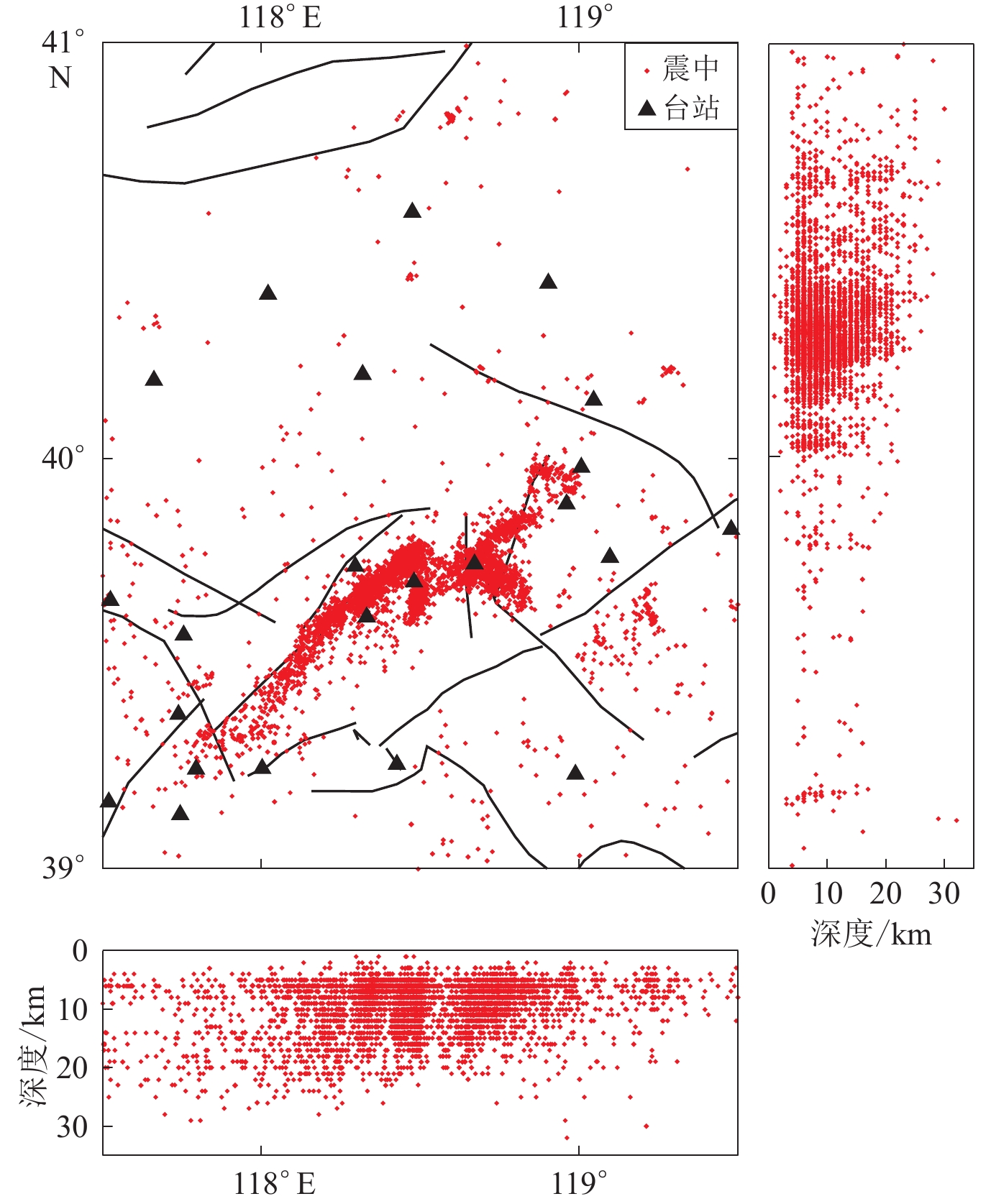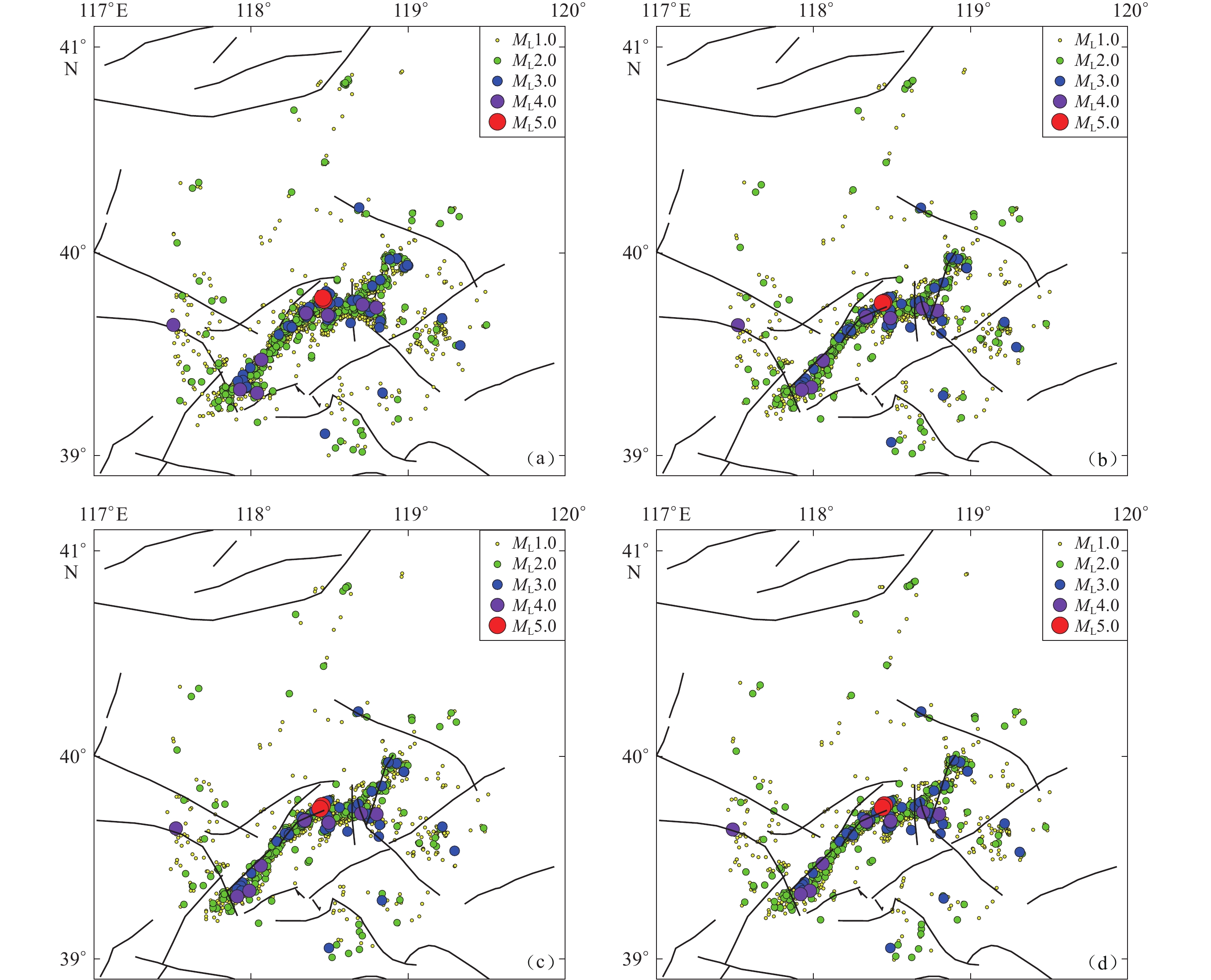Relocation of earthquakes in Tangshan area in the recent decade
-
摘要: 分别运用双差定位法、结合波形互相关的双差定位法和结合波形互相关的双差层析成像法,对唐山地区2010年1月至2020年7月河北地震台网记录的4 874个地震事件进行重定位。结果表明:结合波形互相关的双差层析成像法的定位精度高于其它两种方法,地震走时均方根残差由初始的0.71降至0.27;重定位后的震中分布更加集中,线性分布更明显,优势分布方向为NE向,与该区域断层走向基本一致;重定位后震源深度主要集中在5—15 km,分布形态更接近于正态分布,结果更加合理。从重定位后的震中空间分布可见在唐山—古冶断裂东侧有一个NNE向的高倾角小震密集带,近年来小震活动频繁,分析认为该区域的局部应力较高,构造活动较强,推测在唐山—古冶断裂东端点可能存在隐伏断层,该区域地震的发生与其深部活动有关。Abstract: We relocated 4 874 earthquakes totally which were recorded by Hebei seismic network in Tangshan area during the period between January of 2010 and July of 2020 by using the double-difference relocation method, the double-difference relocation method combined with waveform cross-correlation, and the double-difference tomography method combined with the waveform cross-correlation, respectively. The comparison of the location results by the three relocation methods suggests that the double-difference tomography method combined with the waveform cross-correlation could produce much higher resolution hypocentral parameters than those from the other two methods. As a result, the root-mean-square (RMS) of traveltime residuals were greatly reduced from 0.71 s to 0.27 s. In map view the relocated earthquakes are more concentrated on obvious strips around the faults, and the dominant distribution direction is NE, which is basically consistent with the fault strike in this area. The result is more reasonable in depth distribution with focal depth mainly concentrated in 5−15 km, and the distribution pattern appears as a nearly normal distribution. From the spatial distribution of the epicenters after relocation, it can be seen that there is a small earthquake dense zone with steep dip angle in NNE direction on the east of the Tangshan-Guye fault, indicating that the stress level is high and the tectonic activity is strong in this local area. Therefore it is speculated that there may be a hidden fault at the eastern end of the Tangshan-Guye fault, and the occurrence of earthquake in this region is related to its deep activities.
-
-
图 4 定位后震源深度(上)和定位误差(下)的统计直方图
(a) 仅使用震相报告数据所获的双差定位结果;(b) 结合波形互相关数据和震相报告数据所获的双差定位结果;(c) 结合波形互相关数据和震相报告数据所获的双差层析成像结果
Figure 4. Histogram of focal depth (upper panels) and positioning error (lower panels) after relocation
(a) Double-difference relocation results only using catalog data;(b) Double-difference relocation results combining the waveform cross-correlation data and catalog data;(c) Double-difference seismic tomography results combining waveform cross-correlation data and catalog data
图 3 重定位前、后唐山地区2010—2020年地震的震中分布图
(a) 初始地震事件震中分布; (b) 仅使用震相报告数据所获的双差定位结果(第一组);(c) 结合波形互相关数据和震相报告数据所获的双差定位结果(第二组);(d) 结合波形互相关数据和震相报告数据所获的双差层析成像结果 (第三组)
Figure 3. Distribution of earthquake hypocenters in Tangshan area from 2010 to 2020 before and after relocation
(a) Initial epicentral distribution;(b) Double-difference relocation results only using catalog data (Group 1);(c) Double-difference relocation results combining the waveform cross-correlation data and catalog data (Group 2);(d) Double-difference seismic tomography results combining waveform cross-correlation data and catalog data (Group 3)
表 1 本文所用一维速度模型(引自于湘伟等,2003)
Table 1 One-dimensional velocity model used in this study (after Yu et al,2003)
上界面深度/km P波速度/(km·s−1) 0 5.20 5 5.80 10 6.00 15 6.10 20 6.60 25 6.70 30 6.90 -
陈佳维,崔效锋,胡幸平. 2017. 唐山及周边地区中小地震重定位及其构造特征[J]. 华北地震科学,35(1):1–9. doi: 10.3969/j.issn.1003-1375.2017.01.001 Chen J W,Cui X F,Hu X P. 2017. Middle-small earthquake relocation and tectonic characteristics of Tangshan and its adjacent area[J]. North China Earthquake Sciences,35(1):1–9 (in Chinese).
陈筱青,于湘伟. 2015. 联合多种定位方法对华北地区地震重定位研究[J]. 中国科学院大学学报,32(2):243–251. doi: 10.7523/j.issn.2095-6134.2015.02.014 Chen X Q,Yu X W. 2015. Relocation of earthquakes in North China using absolute and relative earthquake relocation methods[J]. Journal of University of Chinese Academy of Sciences,32(2):243–251 (in Chinese).
董春丽,李乐,赵晋泉,李冬梅,胡玉良,任力伟,徐志国. 2013. 临汾地区的小震精定位分析[J]. 地震地质,35(4):873–886. doi: 10.3969/j.issn.0253-4967.2013.04.016 Dong C L,Li L,Zhao J Q,Li D M. Hu Y L,Ren L W,Xu Z G. 2013. Relocation of small earthquakes in Linfen area,Shanxi,China[J]. Seismology and Geology,35(4):873–886 (in Chinese).
李红光,王利亚,孙刚,张鹤翔,李伟华. 2015. 华北地区中小地震重新定位和地震活动特征研究[J]. 地震,35(1):28–37. doi: 10.3969/j.issn.1000-3274.2015.01.004 Li H G,Wang L Y,Sun G,Zhang H X,Li W H. 2015. Seismicity characterized by relocation of small to moderate earthquake in North China[J]. Earthquake,35(1):28–37 (in Chinese).
刘亢,曲国胜,房立华,李红光. 2015. 唐山古冶、滦县地区中小地震活动与构造关系研究[J]. 地震,35(2):111–120. doi: 10.3969/j.issn.1000-3274.2015.02.012 Liu K,Qu G S,Fang L H,Li H G. 2015. Relationship between tectonics and small to moderate earthquakes in Guye and Luanxian area,Hebei Province[J]. Earthquake,35(2):111–120 (in Chinese).
罗佳宏,马文涛,李春政. 2017. 结合波形互相关的双差定位方法在三峡水库地震中的应用[J]. 震灾防御技术,12(1):56–67. doi: 10.11899/zzfy20170106 Luo J H,Ma W T,Li C Z. 2017. Application of double-difference relocation method combined with waveforms cross-correlation on earthquakes in the Three Gorges reservoir area[J]. Technology for Earthquake Disaster Prevention,12(1):56–67 (in Chinese).
罗艳,崇加军,倪四道,陈棋福,陈颙. 2008. 首都圈地区莫霍面起伏及沉积层厚度[J]. 地球物理学报,51(4):1135–1145. doi: 10.3321/j.issn:0001-5733.2008.04.022 Luo Y. Chong J J,Ni S D,Chen Q F,Chen Y. 2008. Moho depth and sedimentary thickness in Capital region[J]. Chinese Journal of Geophysics,51(4):1135–1145 (in Chinese).
汪锐,谭成轩,安美建,冯梅,卢君,张劲松,毛星. 2013. 结合波形互相关的双差定位在北京西北地区地震活动性研究中的应用[J]. 地学前缘,20(4):115–124. Wang R,Tan C X,An M J,Feng M,Lu J,Zhang J S,Mao X. 2013. Application of double-difference relocation technique and linear location technique to seismic activity in the northwestern Beijing using waveform cross-correlation[J]. Earth Science Frontiers,20(4):115–124 (in Chinese).
王想,王亚茹,郭蕾,王晓山. 2016. 2015年1月11日河北滦县ML3.3震群震兆分析[J]. 地震地磁观测与研究,37(2):41–47. Wang X,Wang Y R,Guo L,Wang X S. 2016. The comprehensive analysis of earthquake precursors significance of the Luanxian ML3.3 earthquake swarm on January 11,2015[J]. Seismological and Geomagnetic Observation and Research,37(2):41–47 (in Chinese).
谢卓娟,吕悦军,方怡,史丙新. 2017. 京津冀地区地震重新定位及其与活动断裂的关系[J]. 地震,37(3):72–83. doi: 10.3969/j.issn.1000-3274.2017.03.008 Xie Z J,Lü Y J,Fang Y,Shi B X. 2017. Relocated seismicity and its relation with active faults in Beijing-Tianjin-Hebei area[J]. Earthquake,37(3):72–83 (in Chinese).
徐杰,牛娈芳,王春华,韩竹君. 1996. 唐山—河间—磁县新生地震构造带[J]. 地震地质,18(3):193–198. Xu J,Niu L F,Wang C H,Han Z J. 1996. Tangshan-Hejian-Cixian newly-generated seismotectonic zone[J]. Seismology and Geology,18(3):193–198 (in Chinese).
于湘伟,陈运泰,王培德. 2003. 京津唐地区中上地壳三维P波速度结构[J]. 地震学报,25(1):1–14. doi: 10.3321/j.issn:0253-3782.2003.01.001 Yu X W,Chen Y T,Wang P D. 2003. Three-dimensional P wave velocity structure in Beijing-Tianjin-Tangshan area[J]. Acta Seismologica Sinica,25(1):1–14 (in Chinese).
于湘伟,陈运泰,张怀. 2010. 京津唐地区中小地震重新定位[J]. 地震学报,32(3):257–269. doi: 10.3969/j.issn.0253-3782.2010.03.001 Yu X W,Chen Y T,Zhang H. 2010. Relocation of earthquakes in Beijing-Tianjin-Tangshan region with double-difference tomography technique[J]. Acta Seismologica Sinica,32(3):257–269 (in Chinese).
曾融生,陆涵行,丁志峰. 1988. 从地震折射和反射剖面结果讨论唐山地震成因[J]. 地球物理学报,31(4):383–398. Zeng R S,Lu H X,Ding Z F. 1988. Seismic refraction and reflection profilings across Tangshan epicentral region and their implication to seismogenic processes[J]. Chinese Journal of Geophysics,31(4):383–398 (in Chinese).
张素欣,边庆凯,张子广,王晓山,曹筠,李永庆. 2020. 唐山断裂北段地震分布特征及其构造意义[J]. 地震研究,43(2):270–277. doi: 10.3969/j.issn.1000-0666.2020.02.008 Zhang S X,Bian Q K,Zhang Z G,Wang X S,Cao J,Li Y Q. 2020. Seismic distribution and tectonic significance of the northern segment of the Tangshan fault[J]. Journal of Seismological Research,43(2):270–277 (in Chinese).
赵博,高原,石玉涛. 2013. 用双差定位结果分析华北地区的地震活动[J]. 地震,33(1):12–21. doi: 10.3969/j.issn.1000-3274.2013.01.002 Zhao B,Gao Y,Shi Y T. 2013. Relocation of small earthquakes in North China using double difference algorithm[J]. Earthquake,33(1):12–21 (in Chinese).
仲秋,史保平. 2012. 1976年唐山MS7.8地震余震序列持续时间及对地震危险性分析的意义[J]. 地震学报,34(4):494–508. doi: 10.3969/j.issn.0253-3782.2012.04.007 Zhong Q,Shi B P. 2012. Aftershock duration of the 1976 MS7.8 Tangshan earthquake and implication for seismic hazard estimation[J]. Acta Seismologica Sinica,34(4):494–508 (in Chinese).
朱琳,李腾飞,石富强,石军,邵辉成. 2021. 1976年唐山强震群震后库仑应力演化及其与2020年古冶5.1级地震的关系[J]. 地震研究,44(1):1–8. doi: 10.3969/j.issn.1000-0666.2021.01.001 Zhu L,Li T F,Shi F Q,Shi J,Shao H C. 2021. The Coulomb stress evolution after the 1976 Tangshan strong earthquake swarm and its relationship with the 2020 Guye M5.1 earthquake[J]. Journal of Seismological Research,44(1):1–8 (in Chinese).
Du W X,Thurber C H,Eberhart-Phillips D. 2004. Earthquake relocation using cross-correlation time delay estimates verified with the bispectrum method[J]. Bull Seismol Soc Am,94(3):856–866. doi: 10.1785/0120030084
Waldhauser F,Ellsworth W L. 2000. A double-difference earthquake location algorithm:Method and application to the northern Hayward fault,California[J]. Bull Seismol Soc Am,90(6):1353–1368. doi: 10.1785/0120000006
Waldhauser F,Ellsworth W L. 2002. Fault structure and mechanics of the Hayward fault,California,from double-difference earthquake locations[J]. J Geophys Res:Solid Earth,107(B3):2054.
Zhang H J,Thurber C H. 2003. Double-difference tomography:The method and its application to the Hayward fault,California[J]. Bull Seismol Soc Am,93(5):1875–1889. doi: 10.1785/0120020190
Zhang H J,Thurber C H. 2006. Development and applications of double-difference seismic tomography[J]. Pure Appl Geophys,163(2/3):373–403.
-
期刊类型引用(4)
1. 陈长龙,刘启方. 三种非线性时变识别方法的对比研究——以2021年日本福岛地震为例. 地震工程学报. 2023(02): 372-381 .  百度学术
百度学术
2. 吴双兰,野津厚,長坂陽介. 2021年日本福岛县冲地震的震源破裂过程分析——基于采用经验格林函数方法的波形反演. 世界地震工程. 2021(02): 1-12 .  百度学术
百度学术
3. 徐志国,梁姗姗,张广伟,梁建宏,邹立晔,李旭茂,陈彦含. 2021年5月22日青海玛多M_S7.4地震发震构造分析. 地球物理学报. 2021(08): 2657-2670 .  百度学术
百度学术
4. 张喆,许力生. 2021年青海玛多M_W7.5地震矩心矩张量解. 地震学报. 2021(03): 387-391 .  本站查看
本站查看
其他类型引用(1)





 下载:
下载:




